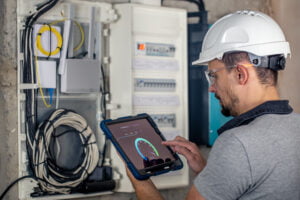Introduction to Energy Management Systems (EMS)
Commercial buildings are significant consumers of energy, comprising a substantial portion of global energy usage. Energy Management Systems (EMS) have emerged as indispensable tools for optimizing power consumption in these structures. An EMS encompasses a suite of technologies and strategies aimed at efficiently monitoring, controlling, and optimizing energy usage within commercial buildings.
In today’s environmentally conscious landscape, the imperative to streamline power usage has never been more pronounced. With concerns about climate change and rising energy costs, businesses are under increasing pressure to operate sustainably while remaining economically viable. Herein lies the importance of EMS, which not only helps in reducing energy consumption but also contributes to cost savings and environmental stewardship.
At its core, an EMS provides real-time insights into energy consumption patterns, allowing building owners and managers to identify areas of inefficiency and implement targeted solutions. By leveraging advanced data analytics and automation, EMS enables precise control over heating, cooling, lighting, and other building systems, optimizing their operation for maximum efficiency.
Throughout this exploration, we will delve into the intricacies of Energy Management Systems, examining their components, benefits, implementation processes, challenges, and prospects. As we navigate this landscape, it becomes apparent that EMS represents a pivotal tool in the quest for sustainable, cost-effective energy usage in commercial buildings.
Benefits of Implementing EMS in Commercial Buildings
Implementing an Energy Management System (EMS) in commercial buildings yields a multitude of benefits, ranging from cost savings to environmental sustainability and operational efficiency. Here are some key advantages:
Cost Savings: EMS allows for precise monitoring and control of energy consumption, enabling businesses to identify inefficiencies and implement strategies to reduce energy waste. By optimizing energy usage, organizations can significantly lower utility bills and operating expenses over time. Moreover, proactive maintenance and predictive analytics facilitated by EMS can prevent costly equipment failures and downtime.
Environmental Impact Reduction: With growing concerns about climate change and environmental sustainability, reducing carbon footprint has become a top priority for businesses. EMS helps in tracking energy usage patterns, identifying areas of excessive consumption, and implementing measures to minimize environmental impact. By promoting energy conservation and efficiency, EMS contributes to mitigating greenhouse gas emissions and promoting a cleaner environment.
Enhanced Operational Efficiency: Real-time monitoring and automated control features of EMS streamline building operations, leading to enhanced efficiency and productivity. By optimizing HVAC systems, lighting, and other equipment based on occupancy schedules and demand patterns, EMS ensures that resources are utilized effectively. This not only improves comfort for occupants but also enhances the overall performance of building systems, leading to smoother operations and reduced maintenance requirements.
Compliance with Regulations and Standards: Regulatory bodies and industry standards increasingly mandate energy efficiency measures for commercial buildings. EMS provides a structured framework for compliance with regulations such as building energy codes and sustainability certifications like LEED (Leadership in Energy and Environmental Design). By ensuring adherence to these standards, businesses can avoid penalties, demonstrate their commitment to sustainability, and gain competitive advantages in the marketplace.
Overall, the implementation of an Energy Management System in commercial buildings offers a wide array of benefits, ranging from financial savings and environmental stewardship to operational efficiency and regulatory compliance. By harnessing the power of data analytics and automation, businesses can transform their energy management practices and unlock long-term value for both their bottom line and the planet.
Key Features of EMS
Energy Management Systems (EMS) offer a suite of features designed to optimize power usage and enhance operational efficiency in commercial buildings. These features leverage technology and data analytics to provide real-time insights and control over energy consumption. Here are some key features of EMS:
Real-Time Monitoring and Data Analysis:
- EMS platforms continuously monitor energy usage across various systems and devices within a building.
- Real-time data analysis identifies patterns, trends, and anomalies in energy consumption.
- Energy usage data is visualized through intuitive dashboards and reports, providing stakeholders with actionable insights.
Automated Control Systems:
- EMS automates control of building systems such as HVAC (Heating, Ventilation, and Air Conditioning), lighting, and equipment.
- Automated scheduling adjusts settings based on occupancy patterns, time of day, and environmental conditions to optimize energy usage.
- Dynamic control algorithms ensure efficient operation while maintaining occupant comfort and safety.
Integration with Building Systems:
- EMS integrates with existing building management systems (BMS), meters, sensors, and IoT devices.
- Integration allows for centralized control and coordination of energy-consuming assets, promoting interoperability and synergy among different systems.
- Seamless communication between EMS and building systems enables holistic energy management strategies.
Demand Response Capabilities:
- EMS enables participation in demand response programs, allowing buildings to adjust energy usage in response to grid conditions or utility signals.
- Demand response strategies include load shedding, peak shaving, and shifting energy consumption to off-peak hours.
- By reducing energy demand during peak periods, buildings can lower electricity costs and alleviate strain on the grid.
Implementation Process of EMS in Commercial Buildings
A. Assessment and Energy Audits:
- Conducting a thorough assessment of the existing energy consumption patterns within the commercial building.
- Identifying areas of inefficiency and opportunities for improvement.
- Performing energy audits to gather detailed data on energy usage, equipment efficiency, and building performance.
- Engaging with energy management professionals or consultants to assist in the assessment process.
B. System Selection and Installation:
- Evaluating available EMS solutions based on the specific needs and requirements of the commercial building.
- Considering factors such as scalability, compatibility with existing infrastructure, and ease of integration.
- Selecting an EMS provider or solution that offers comprehensive features and meets budget constraints.
- Collaborating with vendors and contractors for the installation of EMS hardware and software components.
C. Customization and Configuration:
- Tailoring the EMS to suit the unique characteristics and operational workflows of the commercial building.
- Customizing settings and parameters for energy monitoring, control algorithms, and automated responses.
- Integrating EMS with other building management systems, such as HVAC, lighting, and security systems.
- Training building operators and facility managers on how to effectively use and manage the EMS platform.
D. Training and Maintenance:
- Providing comprehensive training sessions for building staff to ensure they understand the functionality and capabilities of the EMS.
- Establishing protocols and procedures for ongoing maintenance and system optimization.
- Implementing regular monitoring and performance tracking to identify any deviations or issues.
- Conducting periodic software updates and hardware maintenance to keep the EMS running efficiently.
Challenges and Barriers to EMS Adoption
Despite the numerous benefits of Energy Management Systems (EMS) in streamlining power usage in commercial buildings, there are several challenges and barriers that organizations may encounter during the adoption process. Understanding and addressing these challenges is crucial for successful implementation. Here are some key hurdles:
Initial Investment Costs:
- One of the primary obstacles to EMS adoption is the upfront investment required for system installation and setup.
- Many organizations may perceive the initial costs as prohibitive, especially for smaller businesses or those with tight budgets.
- Return on investment (ROI) calculations can be challenging to quantify accurately, leading to hesitancy in committing to EMS implementation.
Technological Complexity:
- EMS systems often involve sophisticated technologies, including sensors, data analytics software, and control systems.
- Understanding and integrating these technologies into existing building infrastructure can be complex and require specialized expertise.
- Training staff to use and maintain the EMS effectively may pose additional challenges, particularly for organizations with limited technical resources.
Organizational Resistance:
- Resistance to change within the organization can impede EMS adoption efforts.
- Stakeholders, including building owners, managers, and occupants, may be reluctant to embrace new technologies or modify established processes.
- Overcoming resistance may require effective communication, stakeholder engagement, and a clear demonstration of the benefits of EMS implementation.
Data Security Concerns:
- The collection and analysis of sensitive energy consumption data raise concerns about data privacy and security.
- Organizations must ensure robust cybersecurity measures are in place to protect against unauthorized access or data breaches.
- Compliance with data protection regulations, such as GDPR or CCPA, adds complexity to EMS implementation and may require additional resources for compliance.
Conclusion
In conclusion, while Energy Management Systems (EMS) offer significant benefits for commercial buildings in optimizing power usage and enhancing sustainability, their adoption is not without challenges. Despite hurdles such as initial investment costs, technological complexity, organizational resistance, and data security concerns, businesses must recognize the long-term advantages of implementing EMS. By addressing these challenges head-on and leveraging innovative solutions, organizations can overcome barriers to adoption and unlock the full potential of EMS in achieving cost savings, reducing environmental impact, and improving operational efficiency.
Furthermore, the future of EMS holds promising advancements and opportunities. With ongoing developments in IoT, sensor technologies, and artificial intelligence, EMS systems are becoming increasingly sophisticated and capable of delivering real-time insights and predictive analytics. Integration with smart grids and renewable energy sources further enhances the resilience and sustainability of commercial buildings. Regulatory support and industry standards continue to evolve, providing a conducive environment for EMS adoption and innovation.
In conclusion, as the demand for energy-efficient and environmentally responsible practices grows, EMS will play an increasingly vital role in shaping the future of power management in commercial buildings. By embracing EMS and overcoming adoption challenges, businesses can position themselves for long-term success while contributing to a more sustainable and resilient built environment. The journey towards effective energy management requires commitment, collaboration, and continuous improvement, but the rewards in terms of cost savings, environmental stewardship, and operational excellence are well worth the effort.












